The Dos and Don'ts of Decorating Your Trees
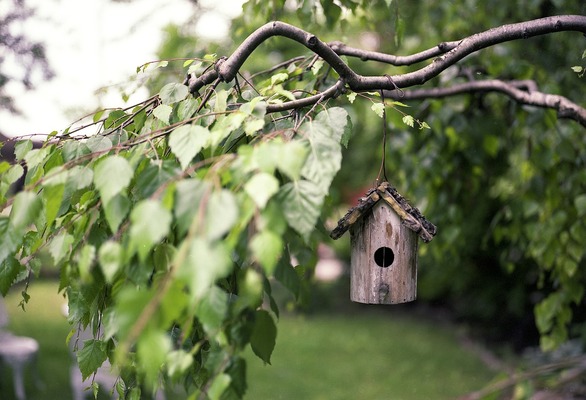
Introduction
Enhancing your outdoor space through tree decoration can breathe new life into your yard. It's a fantastic way to add charm and personality, whether you're aiming to create a festive atmosphere for special occasions or simply boost your garden's visual appeal. However, to ensure your decorating choices are both beautiful and safe for your trees, you'll want to follow some essential guidelines.
In this comprehensive guide, we'll explore the dos and don'ts of tree decoration, covering popular options like lights, birdhouses, signs, and additional creative ideas to make your yard a picturesque haven. From illuminating your trees with outdoor string lights to creating inviting bird habitats with well-placed birdhouses and hanging signs that add a personal touch, we've got you covered.
Join us as we delve into the practical aspects of tree decoration, ensuring that your outdoor space not only looks fantastic but also remains healthy and thriving. Let's embark on this journey where creativity meets practicality and your garden becomes a canvas for your ideas.
Lights
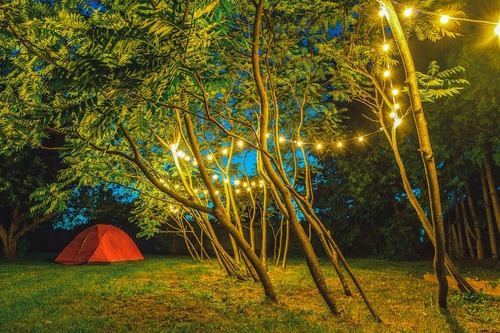
Backyard Trees Decorated with String Lights
The most common decorations you will see on outdoor trees, especially during the upcoming holiday months, are outdoor string lights. Whether you are putting up Christmas lights or simply stringing up some lights for outdoor summer parties, there is a list of dos and don’ts.
What to Do
When it comes to illuminating your trees, consider these guidelines:
- Measure and Plan: Before purchasing and hanging outdoor string lights, measure the tree's height and circumference. Calculate the number of lights needed based on the desired spacing. You will want to decide how far apart you want the lights, and then simply divide the height by that distance. After that, multiply that by the circumference to see how many feet of lights you will need. This meticulous planning ensures a well-balanced and visually appealing lighting display.
- Choose Outdoor Lights: Opt for lights specifically designed for outdoor use to prevent damage and burns to your tree. These lights are weather-resistant and can withstand the elements, ensuring they stay bright and functional.
- Secure Extension Cords: Use weatherproof extension cords and secure them at the base of the tree to avoid tripping hazards and lawn maintenance interference. It's essential to prioritize safety when dealing with electricity.
- Test Lights: Before hanging the lights, it's a good idea to test them to avoid unpleasant surprises, such as half of them not lighting up. Checking each bulb to ensure they all light up can save you time and hassle later on.
- Consider Solar-Powered Lights: For an eco-friendly and cost-effective lighting solution, you can opt for solar-powered lights. These lights harness energy from the sun during the day and illuminate your trees at night, all without the need for extension cords or electricity.
What Not to Do
- Overload Extension Cords: Never connect more than three strands of lights to a single extension cord to ensure electrical safety. Overloading cords can lead to overheating and potentially create fire hazards. If you require more lights, consider using additional extension cords and distribute the load evenly.
- Wrap Lights Too Tightly: Avoid wrapping lights around the tree trunk too tightly, as this can damage the tree's bark and hinder growth. Instead, maintain a gentle touch when securing lights to ensure your tree remains healthy and vibrant.
- Leave Lights Up Year-Round: While festive lighting can add a magical touch to your outdoor space, it's a good practice to take them down after the holiday season or event. Prolonged exposure to outdoor elements may damage the lights and, if left unattended, can create an unsightly appearance in your yard.
- Neglect Maintenance: Regularly inspect your lights for any signs of wear and tear. Replace any faulty bulbs or strands promptly to keep your tree looking its best.
Birdhouses
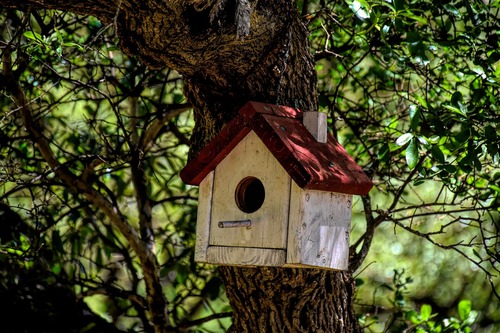
A Wooden Birdhouse Attached to a Tree Trunk
Other common decorations you may be considering for your trees are birdhouses. These are a fantastic way to invite local birds to your yard and give them a place to rest and eat. However, you should be careful about hanging them up.
What to Do
If you want to attract local birds to your yard, consider these recommendations:
- Choose the Right Birdhouse Size: Research bird species in your area and select a birdhouse size that accommodates their preferences. Different bird species may require houses of varying sizes and heights. By catering to the specific needs of local birds, you'll create an attractive habitat that fosters avian visitors.
- Select the Right Tree: Opt for a tree with a diameter of 4 to 12 inches at breast height and low branches that provide perching spots near the birdhouse. A tree with low branches not only offers birds a convenient place to rest but also makes it easier for you to monitor your feathered friends.
- Use Hardwood: Hardwood is a better choice for birdhouses as it doesn't produce sticky sap like pines and other species do. Additionally, consider trees that offer food for the birds, such as hollies, oaks, or cherries. Providing a food source in close proximity to the birdhouse will make your tree an even more inviting location for avian residents.
- Secure with Straps: Use strong fabric or cordage straps to attach the birdhouse to the tree without damaging it. A great option is flat nylon webbing. Attaching Velcro to the fabric can allow you to strap it to the tree without being invasive. Monitoring and loosening the straps periodically is crucial to accommodate tree growth. Securing birdhouses with straps not only safeguards your tree's health but also allows for easy adjustment as the tree matures.
- Clean and Maintain Birdhouses: Regularly clean out birdhouses to ensure a safe and healthy environment for birds. Cleaning should be done once a year, ideally in late winter or early spring. Remove any debris or old nests, and check for signs of wear or damage that might require repairs.
What Not to Do
- Avoid Nails: Do not nail the birdhouse to the tree, as this exposes the inner layers of the tree to potential harm such as bacteria, viruses, insects, and fungi. Drilling screws or nails into the bark can lead to infections, pests, and damage to the tree's vital structures. While your tree will most likely survive this wound, it isn’t a great risk to take. This is especially true of a young, new tree and an already diseased tree. The well-being of your tree is of utmost importance, so take precautions to preserve its health.
- Don't Make It Too Heavy: Keep the birdhouse's weight in check to prevent accidents, especially if mama birds lay eggs in the nest. Lightweight yet sturdy materials can strike the right balance, ensuring the safety of both the birds and your tree.
- Don't Neglect the Perch Area: While low branches offer excellent perching spots, ensure they are sturdy and well-maintained. Weak or diseased branches could pose a danger to birds and your tree. Regularly trim and prune tree branches to maintain a safe and welcoming environment for your avian guests.
- Avoid Placement in High-Traffic Areas: Be mindful of where you place your birdhouses. High-traffic areas could disturb the birds' nesting and resting activities. Opt for quieter spots in your yard that offer privacy and tranquility.
- Don't Make the Straps Too Tight: Straps that stay too tight for too long will cause girdling over time, which will result in the tree's death. It is recommended that you remove the straps once a year to ensure that they are not too tight.
Signs
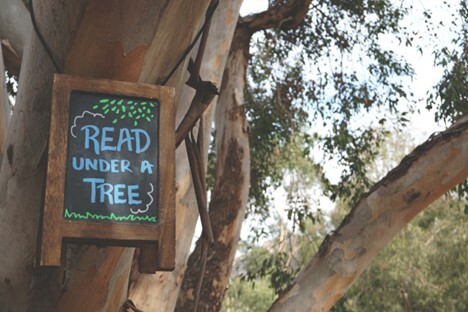
A Chalkboard Sign Hanging on a Tree
Last but not least, let’s talk about hanging signs on your tree. Whether you want a little sign to welcome guests, show off your garden, or just to share a nice thought or quote, there are a lot of great ways to showcase this on a tree sign.
What to Do
For adding decorative signs to your trees, follow these steps:
- Use Straps or Strong Branches: Just like the birdhouses, secure your signs with straps or hang them from sturdy branches to avoid harming the tree's bark. This method ensures that the signs are easily adjustable and can grow with the tree without causing damage.
- Choose Outdoor Materials: Make your sign from materials designed for outdoor use to ensure durability. Weather-resistant materials can withstand exposure to rain, sun, and other elements, ensuring your signs remain vibrant and appealing.
- Opt for Seasonal Themes: Change your signs according to the seasons. Spring might bring cheerful, nature-inspired messages, while winter can feature festive greetings. This rotation keeps your yard fresh and engaging year-round.
- Personalize Your Signs: Get creative with your signs by personalizing them. Add your family's name, a favorite quote, or a welcoming message. Personal touches make your yard unique and inviting.
What Not to Do
- Avoid Nails or Screws: Refrain from nailing or screwing signs to the tree to prevent damage, pests, and infections. When choosing how to secure your signs, prioritize methods that are kind to the tree and that maintain its health.
- Don't Tie Too Tight: Ensure that signs aren't tied too tightly to the tree to allow for unhindered growth. Trees naturally expand as they grow, and tight restraints could impede their development and overall well-being.
- Mind the Mulch: Be cautious when placing signs in mulch near the trees . Ensure that they aren't stabbing any roots or taking up too much soil space. Mulch is a valuable component of tree care, so it's crucial to maintain a healthy balance.
- Regularly Inspect Signs: Check your signs regularly for any damage, fading, or wear. Weather conditions and exposure to the elements can take a toll on outdoor signs. Promptly replace or refurbish signs to keep your yard looking its best.
Additional Creative Ideas for Tree Decoration
Hanging Ornaments
Adding decorative ornaments to your trees can create a whimsical and festive atmosphere. Consider using weather-resistant ornaments made of materials such as plastic, glass, or metal. These ornaments come in various shapes, sizes, and colors, allowing you to customize your tree's appearance to suit different occasions and seasons. To attach them securely, use sturdy hooks or hangers. You can also opt for ornaments that reflect the changing seasons, such as Easter eggs for spring or heart-shaped ornaments for Valentine's Day.
Planting Flowering Vines
Planting flowering vines that climb your trees can be a creative way to add color and texture to your landscape. Select vines that are well-suited for your region and tree type. Some popular choices include clematis, wisteria, and climbing roses. As these vines grow, they'll add a touch of elegance to your tree and create a visually striking backdrop for your yard. Be sure to provide proper support for the vines to climb and train them as needed to maintain a harmonious and well-balanced appearance.
Wind Chimes
Wind chimes not only offer soothing sounds but can also serve as delightful tree decorations. Choose wind chimes that are designed for outdoor use and consider the aesthetic appeal they bring to your yard. The gentle tinkling of wind chimes in the breeze can create a serene atmosphere and make your outdoor space more inviting. Hang them from tree branches using sturdy hooks or cords, ensuring they are within reach to enjoy their melodious tunes.
Tree Art
Turn your trees into living canvases with tree art. You can create tree murals and intricate paintings. This unique form of decoration adds a touch of artistic flair to your yard. When considering tree art, it's essential to prioritize the health of the tree. Avoid causing damage to the bark, which can lead to infections or pests. Choose non-invasive methods like painting or using outdoor-safe adhesives for your tree art.
Maintenance and Long-Term Care
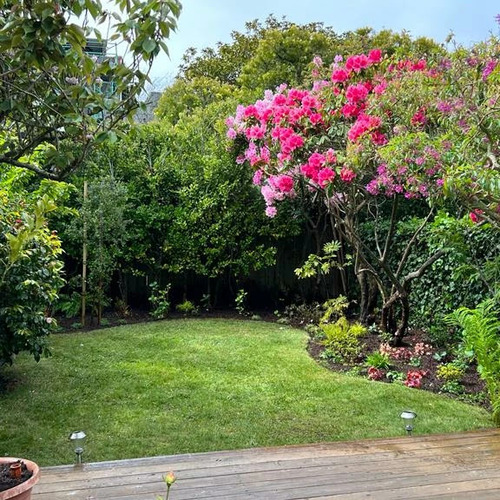
A Backyard Lined with Healthy Trees and Shrubs
As you embark on your tree-decorating journey, it's crucial to prioritize maintenance and long-term care to ensure your trees remain healthy and vibrant. Here are some additional tips:
- Prune Regularly: Regular tree maintenance, including pruning, is essential to keep your trees in optimal condition. Pruning helps remove dead or diseased branches, promotes healthy growth, and maintains the shape and structure of your trees. Consult with an arborist or tree care professional for guidance on proper pruning techniques.
- Monitor for Pests and Disease: Keep a close eye on your trees for signs of pests or disease. If you notice any issues, such as discolored leaves, unusual growths, or pests, take action promptly. Timely intervention can prevent more significant problems from developing.
- Fertilize Appropriately: Depending on the types of trees in your yard, they may benefit from periodic fertilization. Consult with a local nursery or arborist to determine the appropriate fertilization schedule and products for your trees.
- Water Wisely: Proper watering is critical for the health of your trees, especially during dry spells. Be mindful of your tree's specific watering needs, as different tree species have different requirements. Deep watering is generally more effective than frequent, shallow watering.
- Protect Tree Roots: Avoid compacting the soil around your trees' roots by heavy foot traffic or construction activities. Compacted soil can restrict root growth and lead to tree stress. Consider using mulch around the base of the tree to protect and insulate the roots.
- Consult with Professionals: If you have questions or concerns about the health and care of your trees, don't hesitate to consult with a certified arborist. They can provide expert advice and guidance to ensure your trees thrive.
Conclusion
Incorporating decorative elements into your yard can transform it into a welcoming and visually appealing space. Whether you choose to add lights, birdhouses, signs, or get creative with additional tree decoration ideas, it's vital to prioritize the health and well-being of your trees. By following the dos and don'ts of tree decoration, practicing regular maintenance, and consulting with professionals when needed, you can create a picturesque outdoor haven that both you and your guests will enjoy. When in doubt, you can contact Arborist Now to help you determine the best practices to keep your trees healthy. Remember, a beautifully decorated tree is a thriving tree, and a thriving tree contributes to a vibrant and inviting landscape. So, let your imagination flourish and let your trees become the focal points of your outdoor decor.
Originally posted on August 23, 2018





